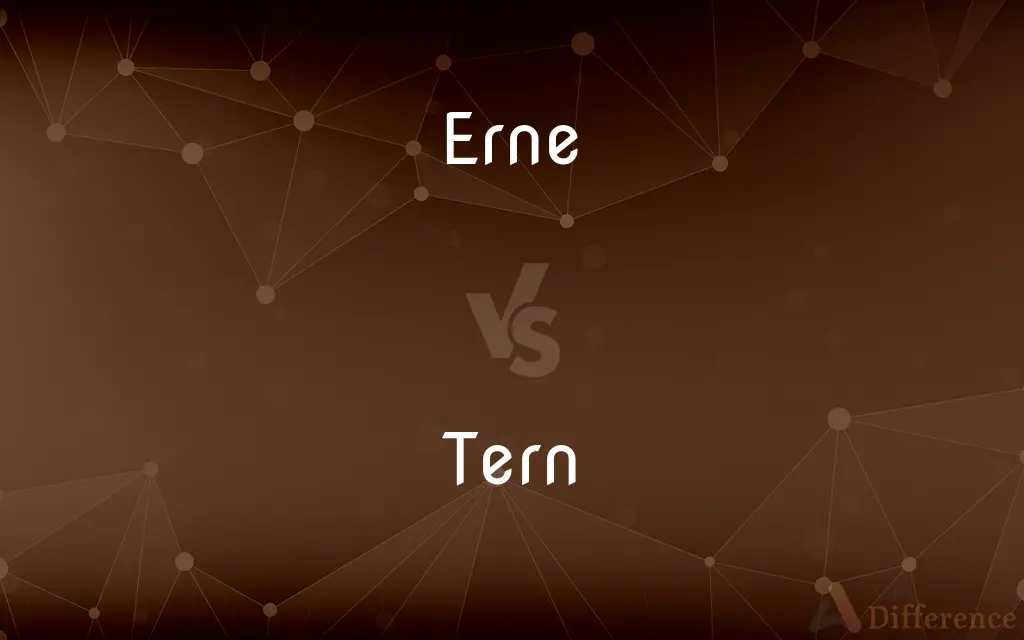Erne vs. Tern — What's the Difference?
By Maham Liaqat & Fiza Rafique — Updated on March 18, 2024
The Erne is a large bird of prey known for its broad wings and white tail, primarily found near water bodies. Tern is a smaller seabird, recognized for its slender body, long wings, and forked tail, commonly found in coastal regions and open seas.

Difference Between Erne and Tern
Table of Contents
ADVERTISEMENT
Key Differences
The Erne, or White-tailed Eagle (Haliaeetus albicilla), is one of the largest birds of prey in its habitat, characterized by its impressive wingspan, broad wings, and distinctive white tail, especially noticeable in adult birds. It primarily feeds on fish, waterfowl, and small mammals, often found near large bodies of water like lakes and coastal areas. Whereas Terns, belonging to the family Sternidae, are relatively smaller seabirds, known for their graceful flight, slender bodies, long and narrow wings, and deeply forked tails. Terns are adapted to a life mostly spent over open water, feeding on fish by diving.
While the Erne exhibits a robust and powerful build, suitable for a bird of prey, with a heavier body and larger talons for catching and holding onto its prey, Terns are more delicate and agile, with lighter bodies and smaller beaks, optimized for their aerial lifestyle and fish-catching technique involving high dives into the water.
Ernes are more solitary or found in pairs, especially during the breeding season, nesting in large trees or cliffs, showing territorial behavior. In contrast, Terns are often seen in flocks, especially during migration or in breeding colonies, nesting on the ground in open areas, which makes communal defense against predators possible.
In terms of habitat, Ernes have a preference for larger, open water bodies in relatively remote areas, often in northern regions, where they can hunt and nest with minimal disturbance. Terns, on the other hand, are highly migratory and can be found in a wide range of coastal environments across the world, from temperate to tropical seas, showcasing a remarkable adaptability to different marine environments.
Comparison Chart
Size
Large, with a wingspan up to 2.4 meters
Smaller, with a wingspan typically less than 1 meter
ADVERTISEMENT
Body Shape
Robust with broad wings and a heavy build
Slender with long, narrow wings and a light build
Tail
Short and wedge-shaped with a white tail in adults
Long and deeply forked
Habitat
Near large bodies of water, coasts, and lakes
Coastal regions, open seas, and inland waterways
Feeding
Fish, waterfowl, and small mammals
Primarily fish, caught by diving
Behavior
Solitary or in pairs, territorial
Often in flocks, highly migratory, breeds in colonies
Nesting
Large trees or cliffs
Ground in open areas
Compare with Definitions
Erne
A large bird of prey known for its white tail and broad wings.
The erne soared above the lake, scanning for fish with its keen eyes.
Tern
A seabird known for its slender build and forked tail.
The terns danced above the waves, their silhouettes against the sunset.
Erne
Prefers solitary or pair living, showing territorial behavior.
The pair of ernes guarded their territory fiercely against intruders.
Tern
Highly migratory, found in diverse coastal environments.
The arrival of terns is a sign of changing seasons along the coast.
Erne
Nests in large trees or on cliffs, away from human disturbance.
Researchers found an erne's nest perched high on a secluded cliff.
Tern
Feeds primarily on fish, catching them with spectacular dives.
The tern emerged from the water, a silver fish held tightly in its beak.
Erne
Found in coastal and lake environments, it's a skilled hunter.
The erne's presence near water bodies indicates a healthy ecosystem.
Tern
Adapted to an aerial lifestyle, they're agile fliers.
Watching a tern dive for fish is a testament to its precision and agility.
Erne
Majestic and powerful, the erne is a symbol of wilderness.
Spotting an erne in the wild is a rare and awe-inspiring experience.
Tern
Forms large breeding colonies, nesting on the ground.
The tern colony buzzed with activity as they prepared for the breeding season.
Erne
A sea eagle, especially Haliaeetus albicilla of Europe.
Tern
Terns are seabirds in the family Laridae that have a worldwide distribution and are normally found near the sea, rivers, or wetlands. Terns are treated as a subgroup of the family Laridae which includes gulls and skimmers and consists of eleven genera.
Erne
A sea eagle (Haliaeetus), especially the white-tailed eagle (Haliaeetus albicilla)
Tern
Any of various seabirds primarily of the genus Sterna found worldwide, typically smaller than a gull and having a forked tail.
Erne
An eagle.
The bald earn
Tern
(Games) A set of three, especially a combination of three numbers that wins a lottery.
Erne
(obsolete) To long; to yearn.
Tern
A three-masted schooner.
Erne
Bulky grayish-brown eagle with a short wedge-shaped white tail; of Europe and Greenland
Tern
Any of various seabirds of the subfamily Sternidae (of the family Laridae) that are similar to gulls but are smaller and have a forked tail.
Tern
A thing with three components; a set of three things.
Tern
A lottery prize resulting from the favourable combination of three numbers in the draw.
Tern
Consisting of three components; ternate, threefold, triple.
Tern flowers; tern leaves
A tern schooner, one with three masts
Tern
Any one of numerous species of long-winged aquatic birds, allied to the gulls, and belonging to Sterna and various allied genera.
Tern
That which consists of, or pertains to, three things or numbers together; especially, a prize in a lottery resulting from the favorable combination of three numbers in the drawing; also, the three numbers themselves.
She'd win a tern in Thursday's lottery.
Tern
Threefold; triple; consisting of three; ternate.
Tern
Small slender gull having narrow wings and a forked tail
Common Curiosities
How can you distinguish an Erne from a Tern in the wild?
Look for size, tail shape, and flight behavior; Ernes are larger with white tails and robust builds, while Terns are smaller, slender, and have forked tails.
What do Ernes typically eat?
They primarily feed on fish, waterfowl, and small mammals.
Where can you typically find Ernes and Terns?
Ernes are found near large bodies of water and coasts, mainly in northern regions, while Terns are widely distributed along coasts and open seas globally.
Are Ernes solitary or social birds?
Ernes are more solitary or found in pairs, especially during breeding seasons, and are known to be territorial.
How do Terns catch their food?
Terns dive from the air into the water to catch fish.
How do Terns nest and raise their young?
Terns nest in large colonies on the ground in open areas, which allows for communal defense against predators.
Are Ernes endangered?
The conservation status of Ernes can vary by region, but they have faced threats from habitat loss and pollution.
Do Terns migrate long distances?
Many Tern species are highly migratory, traveling vast distances between breeding and wintering grounds.
Can Terns be seen inland?
Yes, some Tern species can be found in inland waterways and lakes, especially during migration.
What role do Ernes and Terns play in their ecosystems?
Both are important indicators of the health of aquatic ecosystems; Ernes as top predators and Terns as part of the marine food web.
Can Terns and Ernes coexist in the same habitat?
While they may share some habitats like coastal areas, their differing lifestyles and diets generally minimize direct competition.
How do human activities impact Ernes and Terns?
Both can be affected by habitat destruction, pollution, and climate change, impacting their breeding grounds and food sources.
What measures are being taken to protect Ernes?
Conservation efforts include habitat protection, legal protections, and, in some areas, reintroduction programs.
How can individuals contribute to the conservation of Ernes and Terns?
Supporting habitat conservation efforts, reducing pollution, and respecting wildlife laws and guidelines can help protect these bird species.
Why are Tern colonies important for conservation?
Protecting Tern colonies helps ensure the survival of these species, as their nesting sites are vulnerable to human disturbance and environmental changes.
Share Your Discovery

Previous Comparison
Stats vs. Status
Next Comparison
Covetousness vs. GreedAuthor Spotlight
Written by
Maham LiaqatCo-written by
Fiza RafiqueFiza Rafique is a skilled content writer at AskDifference.com, where she meticulously refines and enhances written pieces. Drawing from her vast editorial expertise, Fiza ensures clarity, accuracy, and precision in every article. Passionate about language, she continually seeks to elevate the quality of content for readers worldwide.
















































